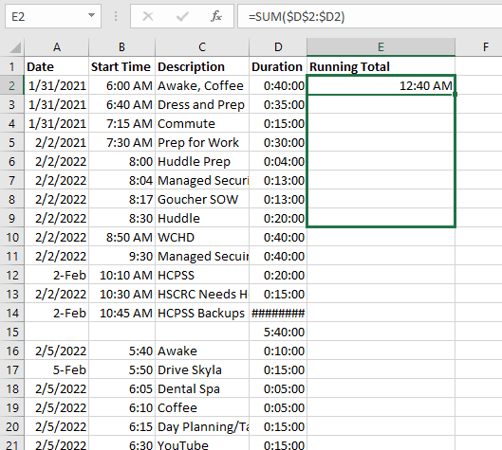Digital Transformation is an “engine” that collects and uses data as fuel to make ever-improving...
How to Improve Data Entry for Digital Transformation: Quantity Over Quality
-png-1.png)
There are some simple ways to make data entry simpler, faster, and more useful when making decisions about your investments as part of the digital transformation process. This involves adding to your daily timekeeping system and ultimately favoring quantity of data over quality.
So, what are the simple steps you can take for better data entry, which will ultimately lead to better digital transformation?
1. Use calculated fields in your spreadsheet
2. Excel’s predictive entry features
3. Prioritizing quantity over quality
In this post, we are going to continue exploring the best ways to track how you are investing your time throughout each day and which new strategies to add to your timekeeping system.
Using Excel to Calculate & Automate Data
Adding a "Running Total" calculated field to the timekeeping spreadsheet is the logical next step to take in your data entry process. You will want to start at midnight and work your way forward to see how much of the day you spend on certain activities.Here is an easy guide to setting up the “Running Total Per Day” column in your spreadsheet.
For my own example, I selected cell E2 so that I could type in the formula “=SUM($D$2:$D2)”
Don't worry about formatting right now. We will fix that and any formulae later in the process. For now, you just want to see if you can transpose this formula easily within your existing table of data.

What you'll need to do to apply this to the entire column is select E2. Notice that dot in the lower left-hand corner of Cell E2? Click and Drag that straight down.



Quantity of Data vs Quality of Data
Now we are going to take a closer look at the debate between quantity versus quality and how that relates to your data entries for digital transformation.
At the Paul G. Allen School of Computer Science & Engineering there is a fable taught in the Introduction to HCI (Human Computer Interaction) Theory and Techniques class. The fable is about an economics study on two pottery classes:
The professor explains to the first pottery class that they will be graded by the quality of a single final submission at the end of the semester. The entire class will get a single grade, and it will entirely depend on that final piece alone.
The professor then explains to the second class that they will be graded by the quantity of their final submission. They will have a single weigh-in at the end of the semester, and their grade will be based on how much the final submission weighs
The question asked at the Paul G. Allen school is simple: The Quantity Class received a better finale grade. Why?
Here is the Answer:
“While the Quantity Class was busily churning out piles of work and learning from their mistakes, the Quality Class had sat there theorizing and perfecting and in the end had little more to show for their efforts than grandiose theories and a pile of dead clay.”
The fact that there was no chance for the Quantity Class to fail meant that they not only avoided penalization, but they were also rewarded for trying new things.
This prevents getting stuck with any initial ideas and leads to ideas that can be mashed and merged together. Additionally, finding alternatives along the way provides for easy comparison and feedback which can even improve the tone of critiques.
Although this may be a made-up story, it is a good one. And it applies to the idea of not overthinking your data entry journey. Get started, collect data, and adapt the strategies as you go. -png.png)
Why Does Digital Transformation Work?
Digital Transformation works because it an engine is based upon the engineering design concept of:
Convergence => Prototyping => Feedback => Prototyping => More Feedback => More Value Data => Better Prototyping
One of the key goals of Digital Transformation is to increase the value of data that we capture over time as we continue to collect more and more data. The best way to do that is to simply increase the quantity of data we capture every day. An easy way to increase the quantity is to start using the automation technique outlined above in your Excel spreadsheet.
This is definitely a good way to make quick, consistent data entries. However, you also need to make sure the data is clean, normalized, and minty fresh. The fresher the data, the stronger your future decision-making process will be for digital transformation.
How Does This Benefit Your Investment Strategies?
When done effectively and successfully, the key major benefit of Digital Transformation is the ability to make better predictions about shorter term investments. Think of it this way: more wins, less risk, and cutting our losses faster.
To get better data, remember these final additional tips:
- Make sure to record the beginning of an activity
- Make sure you are keeping the data formatted in ways that it can be quickly understood (either by man or machine)
- Stay consistent with your data entries
So now that we have focused on collecting a higher quantity of data, we will be moving on to the topic of Taxonomy in the next blog post. You have collected all of this data, but what is next in the digital transformation process?
Taxonomy is all about the classification of data. This will help you sort through all of that data, organize it in a visual way, and then determine how it can be used to make better decisions.
Until then, don’t forget to subscribe to the blog and contact us if you want to chat about how digital transformation can change your business.


.png?height=200&name=LinkedIn%202%20(3).png)
.png?height=200&name=LinkedIn%202%20(6).png)
-png.png?height=200&name=LinkedIn%20Blog%20Image-1%20(6)-png.png)